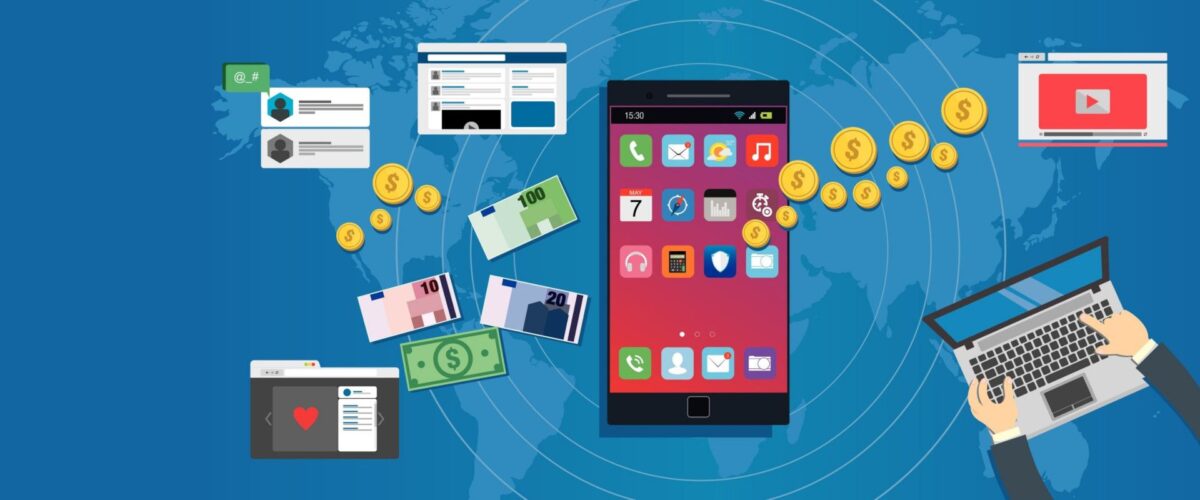Turning Your Mobile App into a Revenue Machine

In today’s digital age, mobile apps have become integral to daily life. From social media platforms to e-commerce, entertainment, and fitness, apps dominate how people interact with the world. For app developers and businesses, the challenge isn’t just building an app that attracts users, but also creating a strategy that turns those users into a steady stream of revenue. Monetizing your mobile app effectively can transform it into a revenue-generating machine, and understanding the right approaches is key to success.
In this guide, we’ll walk you through the top monetization strategies for mobile apps, the pros and cons of each method, and how to maximize your revenue while maintaining a great user experience.
The Foundations of Mobile App Monetization
Before diving into the different methods of monetizing your app, it’s essential to understand a few fundamental principles. The success of any e-commerce mobile app development monetization strategy relies on three main factors:
- User Acquisition: You need a solid user base to monetize effectively. No matter how good your strategy is, it won’t generate substantial revenue if you don’t have enough users.
- User Retention: Keeping users engaged is just as important as acquiring them. High retention rates mean users are more likely to convert into paying customers or interact with ads, which is vital for long-term revenue generation.
- User Experience: The monetization approach should not detract from the user experience. Balancing profitability and user satisfaction is crucial to avoid alienating your audience. A poorly implemented monetization strategy can drive users away, ultimately reducing revenue potential.
Top Mobile App Monetization Strategies
In-App Purchases (IAPs)
One of the most popular and profitable ways to monetize a mobile app is through in-app purchases (IAPs). This model allows users to buy virtual goods, features, or content within the app. Common examples include unlocking new levels in games, purchasing virtual currency, or accessing premium features.
Types of In-App Purchases:
- Consumable IAPs: Items that can be purchased and used multiple times, such as coins, lives, or boosts in a game.
- Non-Consumable IAPs: These are one-time purchases that unlock permanent features, such as ad-free experiences or access to premium content.
- Subscriptions: Users pay a recurring fee for ongoing access to features or content, which can be billed monthly or annually.
Pros of In-App Purchases:
- Offers continuous revenue opportunities, especially with consumables and subscriptions.
- Encourages higher user engagement, as users may return to the app to make additional purchases.
- Can be integrated without affecting the core user experience, allowing free access to the app while still generating revenue.
Cons of In-App Purchases:
- User resistance if they feel pressured into making purchases to enjoy the app fully.
- Balancing the amount of free content and purchasable content can be tricky, as too much free content might reduce the incentive to buy.
Freemium Model
The freemium model is a widely used monetization strategy where the app is free to download and use, but premium features require payment. This model is particularly popular for productivity apps, fitness apps, and games.
In a freemium model, users get access to the basic functionality, while advanced features (such as additional tools, exclusive content, or personalized experiences) are locked behind a paywall.
Pros of the Freemium Model:
- Wider user acquisition as it offers free access to the app, lowering the barrier for entry.
- Allows users to experience the app before committing to paying, increasing the likelihood of conversions.
- The free tier can be used to engage users, with the premium features serving as an incentive to upgrade.
Cons of the Freemium Model:
- Requires careful planning of what to offer for free and what to charge for.
- A significant percentage of users may never upgrade, limiting revenue potential.
Subscription-Based Monetization
The subscription model has gained immense popularity, especially with the rise of content apps such as streaming services, news apps, and education platforms. Under this model, users pay a recurring fee (monthly, quarterly, or annually) to access premium content or features.
Pros of Subscription Monetization:
- Predictable revenue stream, as users commit to paying regularly.
- Encourages long-term user engagement and loyalty, as users are more likely to return to an app they are paying for.
- Suitable for a variety of app types, including news, fitness, entertainment, and education apps.
Cons of Subscription Monetization:
- Requires continuous content updates or new features to keep users subscribed.
- May alienate users who are unwilling to pay for ongoing access, especially if they perceive the free version as insufficient.
In-App Advertising
One of the easiest ways to monetize an app without charging users is through in-app advertising. This method allows developers to integrate ads directly into the app, with revenue generated based on clicks or impressions.
Popular Types of In-App Ads:
- Banner Ads: Small, static ads that are usually placed at the top or bottom of the screen.
- Interstitial Ads: Full-screen ads that appear at natural transition points within the app, such as after completing a level in a game.
- Rewarded Ads: Users are offered in-app rewards (such as extra lives, coins, or premium features) in exchange for watching an ad.
- Native Ads: Ads that blend seamlessly into the app’s content or user interface, making them less intrusive.
Pros of In-App Advertising:
- Provides consistent revenue without requiring users to pay.
- Can be combined with other monetization strategies, such as freemium or in-app purchases.
- Rewarded ads, in particular, can enhance user engagement by offering incentives.
Cons of In-App Advertising:
- Too many ads can lead to a poor user experience and cause users to abandon the app.
- Banner and interstitial ads can disrupt the flow of the app, leading to frustration.
Sponsorship and Partnerships
Another less common but highly effective monetization strategy is sponsorships and partnerships. This approach involves collaborating with brands or businesses that want to promote their products or services to your app’s user base.
Pros of Sponsorship and Partnerships:
- Can result in high revenue from a single deal or ongoing sponsorship.
- Offers customized ad experiences that are tailored to your app’s audience, which can be more engaging than standard ads.
Cons of Sponsorship and Partnerships:
- May require a large user base or niche audience to attract sponsors.
- The process of finding and negotiating sponsorships can be time-consuming.
Data Monetization
In the era of big data, apps can also generate revenue by collecting and selling user data (in compliance with privacy laws, such as GDPR and CCPA). This strategy is often used by free apps, where developers anonymize and sell user data to third parties for market research or advertising purposes.
Pros of Data Monetization:
- Provides an additional revenue stream without charging users.
- Suitable for apps that gather valuable insights into user behavior or trends.
Cons of Data Monetization:
- Can raise privacy concerns, and users may be wary of apps that collect and sell their data.
- Strict regulations around data privacy can make this approach challenging to implement.
Crowdfunding
While not as widely used as other monetization strategies, crowdfunding can be a viable option for apps with a dedicated fan base. Platforms like Patreon or Kickstarter allow app developers to seek funding directly from users, offering exclusive benefits in return for financial support.
Pros of Crowdfunding:
- Engages users by giving them a stake in the app’s success.
- Can provide a steady stream of income from loyal supporters.
Cons of Crowdfunding:
- Relies on building a large, passionate user base willing to contribute financially.
- May not generate as much revenue as other monetization methods.
Choosing the Right Monetization Strategy for Your App
Not all monetization strategies are suitable for every app. The right approach depends on your target audience, app category, and long-term goals. For example:
- Gaming apps may benefit from a combination of in-app purchases, freemium models, and rewarded ads.
- Content apps such as streaming services, news, or education platforms may thrive with subscription-based monetization.
- Utility or productivity apps could incorporate in-app purchases for premium features, while offering a freemium tier for broader access.
It’s also important to remember that hybrid monetization combining two or more strategies often leads to the best results. For example, many freemium apps successfully implement in-app ads alongside in app purchases, creating multiple revenue streams.
Testing and Optimizing Your Monetization Strategy
Once you’ve chosen the right approach or combination of strategies, the work doesn’t stop there. Continuously testing and optimizing your monetization efforts will allow you to maximize revenue without negatively impacting your users.
- A/B Testing: Experiment with different placements for ads, varying price points for in-app purchases, or offering different types of subscription plans. A/B testing helps you identify what works best for your audience.
- Track Key Metrics: Keep a close eye on conversion rates, user engagement, and churn rates. These metrics will indicate how well your monetization strategies are performing and where adjustments are needed.
- Optimize User Experience: Ensure that the introduction of ads, purchases, or subscriptions does not detract from the overall app experience. Make the path to purchasing seamless and ensure that ads are relevant and not overly intrusive.
- User Feedback: Regularly gather feedback from your users about their experience with your app’s monetization. This will help you identify areas for improvement and ensure you maintain high levels of user satisfaction.
Future Trends in App Monetization
As the mobile app ecosystem continues to evolve, so too do monetization strategies. Keeping an eye on emerging trends will ensure your app remains competitive and profitable.
- Increased Use of Artificial Intelligence (AI): AI will play a larger role in app monetization by offering more personalized experiences and tailored recommendations. Expect to see more apps using AI to optimize in-app purchases and deliver ads that resonate with individual users.
- Subscription Bundling: Much like streaming services offering bundles, mobile apps may begin bundling services to offer greater value and attract more paying users. This is particularly relevant for content-driven apps.
- Augmented Reality (AR) and Virtual Reality (VR): As AR and VR technology become more mainstream, app developers will have new opportunities to monetize immersive experiences. In-app purchases for virtual goods in AR/VR games and apps are set to increase.
- Blockchain and NFTs: Blockchain technology and non-fungible tokens (NFTs) are gaining traction as monetization tools, particularly in gaming apps. These technologies enable the creation of unique, ownable digital items that can be bought and sold within apps.
Scaling Your App into a Revenue Powerhouse
Conclusion
Monetizing a mobile app effectively is both an art and a science. To turn your app into a true revenue machine, you need to carefully choose the right monetization strategies that align with your app’s goals and user base. Whether through in-app purchases, subscriptions, advertising, or even sponsorships, each method offers unique benefits and challenges. The key to success lies in balancing profitability with a seamless user experience, ensuring that your monetization efforts enhance, rather than detract from, your app’s value.







